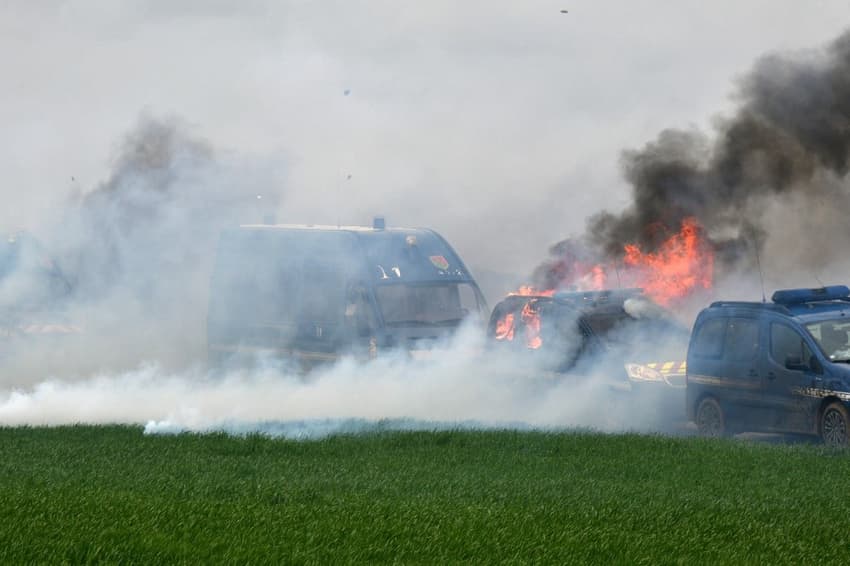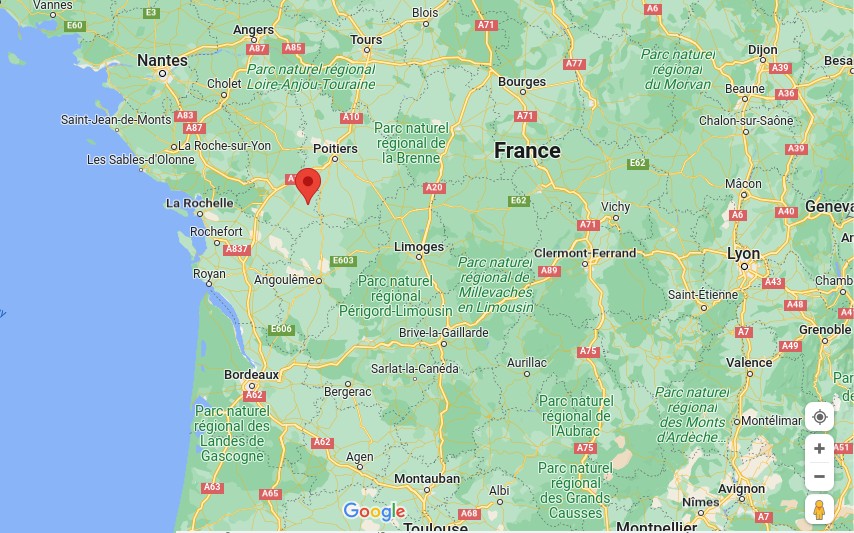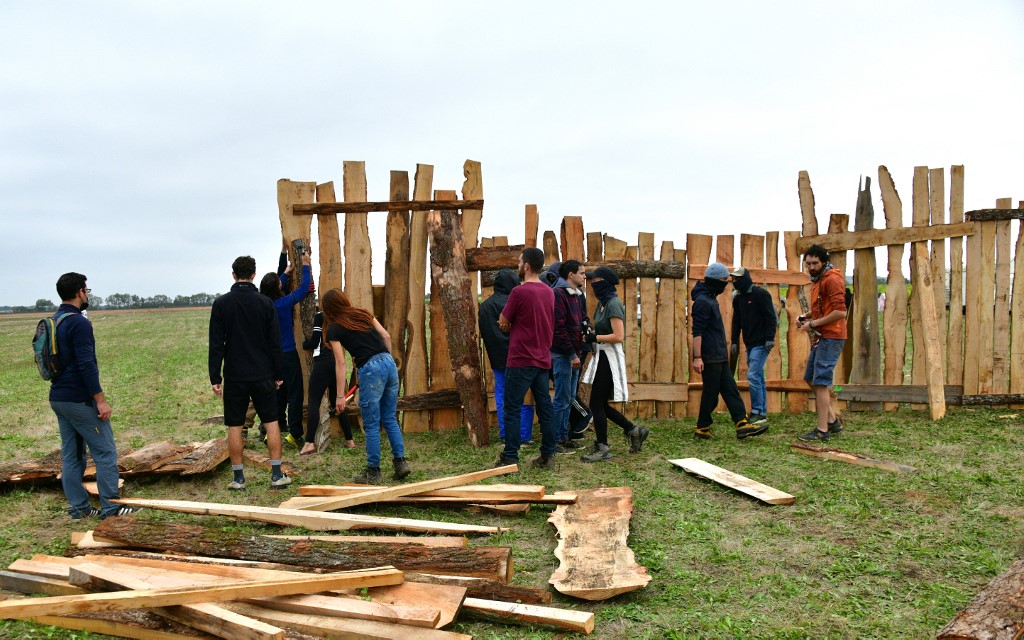Méga-bassines: Why has a dispute over irrigation in French farmland turned violent?

There have been new calls for demonstrations against an irrigation project in western France, so what are the 'méga-bassines' that have been provoking confrontation for over a year?
Organisers have called for a 'water convoy', consisting of hundreds of cyclists and several dozen tractors, to protest against the construction of méga-bassines in western France.
Previous protests, namely those in the town of Sainte-Soline (the sight of the would-be mega-basins) have turned violent, and in March 2023, two protesters were severely injured, and several dozen police officers sustained injuries as well.
However, this was not the first clash at the site of the 'mega-basins' of Sainte-Soline, in October 2022 Molotov cocktails were thrown and more than 60 police officers injured in a three-day series of clashes.
So what's it all about and why has it become such a big issue?
The issue
The protests - which have been ongoing in various forms for more than a year - are against the installation of an agricultural irrigation project in the commune of Sainte-Soline in the Deux-Sèvres département in south-west France.

Location of Sainte-Soline, where the protest camps are being set up. Google Maps
The 'méga-bassines' are a planned network of 16 giant (around 600,000 cubic metres) underwater storage areas which farmers can use for irrigation in the event of a drought - something that is happening with increasing frequency as the planet warms.
The project, backed by around 400 local farmers, is controversial because environmentalists say the mega-basins damage valuable wetland areas - the west of France has several wetland areas that shelter a wide variety of wildlife and the area is also known for salt marshes that produce a highly prized fleur de sel.
The protesters also say that the water tanks drain water from natural groundwater supplies and therefore make droughts worse for local residents and smaller farmers - essentially they see the basins as a 'water theft' from locals by big agri-businesses.
As the climate crisis intensifies and droughts become commonplace, violent clashes over water supplies are likely to become more frequent.
The protests
October 2022 saw the first major clash at the site, but there had been protests in and around the basins for months, which stepped up during the elections in April and June 2022.
In total at the October protest there were between 4,000 and 7,000 demonstrators (estimates according to police and the demo organisers) and 1,500 police.
According to Interior Minister Gérald Darmanin, about 40 of the people present at the demo were on a police watchlist because of a history of violent protest (more on that later).

Activists constrict a 'village of the Gauls' protest camp at Sainte-Soline. Photo by Pascal Lachenaud / AFP
An enormous police presence - around 1,000 officers - was dedicated to trying to stop the creation of a ZAD (Zone à défendre) - a type of permanent protest camp - next to the basin site.
However one farmer allowed protesters to set up camp on his land, where watchtowers and fences were built to create a "village of Gauls", a reference to the popular Asterix comic books.
Despite the protests, construction has begun on the basins, which are heavily guarded.
The violence over the weekend happened when protesters arrived at the construction site, which was defended by the police and gendarmes. Clashes quickly broke out between the more radical activists and the security forces, AFP correspondents said.
Protesters threw projectiles including improvised explosives, and set fire to police vehicles, while police responded with tear gas, water cannon and rubber bullets.
What does the government say?
Gérald Darmanin, France's hardline Interior Minister, has previously described the protests as "écoterrorisme" and saying that at least 40 of the activists at the site are 'Fiché S' - the technical term for being on a police watchlist - due to what he described as 'ultra-left' activities.
"With their operating methods, I am not afraid to say, falling under the banner of eco-terrorism that we must absolutely fight" he declared.
The protests in March coincided with other huge demonstrations in France - a small minority of them violent - against Emmanuel Macron's pension reform, raising the retirement age from 62 to 64.
French police were strongly criticised - including by Amnesty International - for their policing of pension reform protests, with numerous videos showing officers attacking apparently peaceful protesters.
Comments (1)
See Also
Organisers have called for a 'water convoy', consisting of hundreds of cyclists and several dozen tractors, to protest against the construction of méga-bassines in western France.
Previous protests, namely those in the town of Sainte-Soline (the sight of the would-be mega-basins) have turned violent, and in March 2023, two protesters were severely injured, and several dozen police officers sustained injuries as well.
However, this was not the first clash at the site of the 'mega-basins' of Sainte-Soline, in October 2022 Molotov cocktails were thrown and more than 60 police officers injured in a three-day series of clashes.
So what's it all about and why has it become such a big issue?
The issue
The protests - which have been ongoing in various forms for more than a year - are against the installation of an agricultural irrigation project in the commune of Sainte-Soline in the Deux-Sèvres département in south-west France.

The 'méga-bassines' are a planned network of 16 giant (around 600,000 cubic metres) underwater storage areas which farmers can use for irrigation in the event of a drought - something that is happening with increasing frequency as the planet warms.
The project, backed by around 400 local farmers, is controversial because environmentalists say the mega-basins damage valuable wetland areas - the west of France has several wetland areas that shelter a wide variety of wildlife and the area is also known for salt marshes that produce a highly prized fleur de sel.
The protesters also say that the water tanks drain water from natural groundwater supplies and therefore make droughts worse for local residents and smaller farmers - essentially they see the basins as a 'water theft' from locals by big agri-businesses.
As the climate crisis intensifies and droughts become commonplace, violent clashes over water supplies are likely to become more frequent.
The protests
October 2022 saw the first major clash at the site, but there had been protests in and around the basins for months, which stepped up during the elections in April and June 2022.
In total at the October protest there were between 4,000 and 7,000 demonstrators (estimates according to police and the demo organisers) and 1,500 police.
According to Interior Minister Gérald Darmanin, about 40 of the people present at the demo were on a police watchlist because of a history of violent protest (more on that later).

An enormous police presence - around 1,000 officers - was dedicated to trying to stop the creation of a ZAD (Zone à défendre) - a type of permanent protest camp - next to the basin site.
However one farmer allowed protesters to set up camp on his land, where watchtowers and fences were built to create a "village of Gauls", a reference to the popular Asterix comic books.
Despite the protests, construction has begun on the basins, which are heavily guarded.
The violence over the weekend happened when protesters arrived at the construction site, which was defended by the police and gendarmes. Clashes quickly broke out between the more radical activists and the security forces, AFP correspondents said.
Protesters threw projectiles including improvised explosives, and set fire to police vehicles, while police responded with tear gas, water cannon and rubber bullets.
What does the government say?
Gérald Darmanin, France's hardline Interior Minister, has previously described the protests as "écoterrorisme" and saying that at least 40 of the activists at the site are 'Fiché S' - the technical term for being on a police watchlist - due to what he described as 'ultra-left' activities.
"With their operating methods, I am not afraid to say, falling under the banner of eco-terrorism that we must absolutely fight" he declared.
The protests in March coincided with other huge demonstrations in France - a small minority of them violent - against Emmanuel Macron's pension reform, raising the retirement age from 62 to 64.
French police were strongly criticised - including by Amnesty International - for their policing of pension reform protests, with numerous videos showing officers attacking apparently peaceful protesters.
Join the conversation in our comments section below. Share your own views and experience and if you have a question or suggestion for our journalists then email us at [email protected].
Please keep comments civil, constructive and on topic – and make sure to read our terms of use before getting involved.
Please log in here to leave a comment.